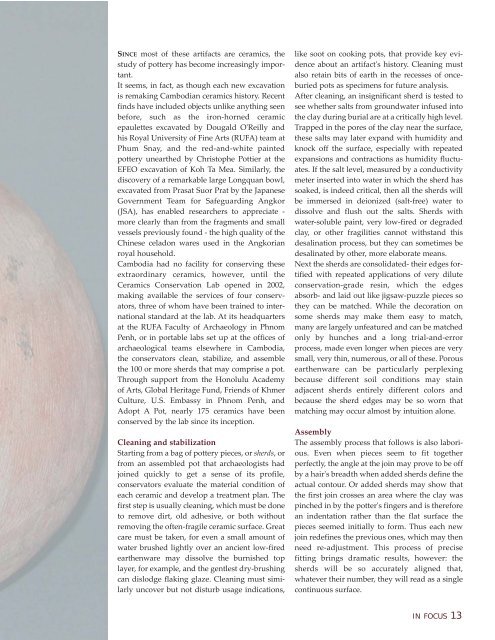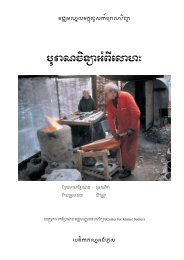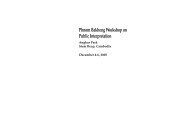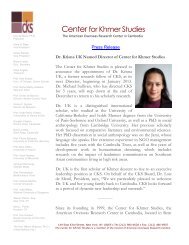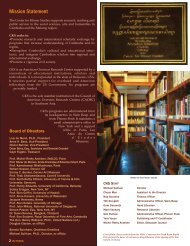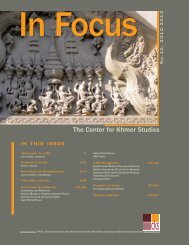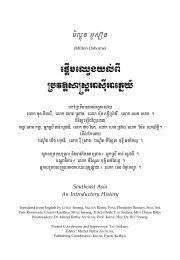In focus 2005-2006.qxd - Center for Khmer Studies
In focus 2005-2006.qxd - Center for Khmer Studies
In focus 2005-2006.qxd - Center for Khmer Studies
Create successful ePaper yourself
Turn your PDF publications into a flip-book with our unique Google optimized e-Paper software.
SINCE most of these artifacts are ceramics, the<br />
study of pottery has become increasingly important.<br />
It seems, in fact, as though each new excavation<br />
is remaking Cambodian ceramics history. Recent<br />
finds have included objects unlike anything seen<br />
be<strong>for</strong>e, such as the iron-horned ceramic<br />
epaulettes excavated by Dougald O'Reilly and<br />
his Royal University of Fine Arts (RUFA) team at<br />
Phum Snay, and the red-and-white painted<br />
pottery unearthed by Christophe Pottier at the<br />
EFEO excavation of Koh Ta Mea. Similarly, the<br />
discovery of a remarkable large Longquan bowl,<br />
excavated from Prasat Suor Prat by the Japanese<br />
Government Team <strong>for</strong> Safeguarding Angkor<br />
(JSA), has enabled researchers to appreciate -<br />
more clearly than from the fragments and small<br />
vessels previously found - the high quality of the<br />
Chinese celadon wares used in the Angkorian<br />
royal household.<br />
Cambodia had no facility <strong>for</strong> conserving these<br />
extraordinary ceramics, however, until the<br />
Ceramics Conservation Lab opened in 2002,<br />
making available the services of four conservators,<br />
three of whom have been trained to international<br />
standard at the lab. At its headquarters<br />
at the RUFA Faculty of Archaeology in Phnom<br />
Penh, or in portable labs set up at the offices of<br />
archaeological teams elsewhere in Cambodia,<br />
the conservators clean, stabilize, and assemble<br />
the 100 or more sherds that may comprise a pot.<br />
Through support from the Honolulu Academy<br />
of Arts, Global Heritage Fund, Friends of <strong>Khmer</strong><br />
Culture, U.S. Embassy in Phnom Penh, and<br />
Adopt A Pot, nearly 175 ceramics have been<br />
conserved by the lab since its inception.<br />
Cleaning and stabilization<br />
Starting from a bag of pottery pieces, or sherds, or<br />
from an assembled pot that archaeologists had<br />
joined quickly to get a sense of its profile,<br />
conservators evaluate the material condition of<br />
each ceramic and develop a treatment plan. The<br />
first step is usually cleaning, which must be done<br />
to remove dirt, old adhesive, or both without<br />
removing the often-fragile ceramic surface. Great<br />
care must be taken, <strong>for</strong> even a small amount of<br />
water brushed lightly over an ancient low-fired<br />
earthenware may dissolve the burnished top<br />
layer, <strong>for</strong> example, and the gentlest dry-brushing<br />
can dislodge flaking glaze. Cleaning must similarly<br />
uncover but not disturb usage indications,<br />
like soot on cooking pots, that provide key evidence<br />
about an artifact's history. Cleaning must<br />
also retain bits of earth in the recesses of onceburied<br />
pots as specimens <strong>for</strong> future analysis.<br />
After cleaning, an insignificant sherd is tested to<br />
see whether salts from groundwater infused into<br />
the clay during burial are at a critically high level.<br />
Trapped in the pores of the clay near the surface,<br />
these salts may later expand with humidity and<br />
knock off the surface, especially with repeated<br />
expansions and contractions as humidity fluctuates.<br />
If the salt level, measured by a conductivity<br />
meter inserted into water in which the sherd has<br />
soaked, is indeed critical, then all the sherds will<br />
be immersed in deionized (salt-free) water to<br />
dissolve and flush out the salts. Sherds with<br />
water-soluble paint, very low-fired or degraded<br />
clay, or other fragilities cannot withstand this<br />
desalination process, but they can sometimes be<br />
desalinated by other, more elaborate means.<br />
Next the sherds are consolidated- their edges <strong>for</strong>tified<br />
with repeated applications of very dilute<br />
conservation-grade resin, which the edges<br />
absorb- and laid out like jigsaw-puzzle pieces so<br />
they can be matched. While the decoration on<br />
some sherds may make them easy to match,<br />
many are largely unfeatured and can be matched<br />
only by hunches and a long trial-and-error<br />
process, made even longer when pieces are very<br />
small, very thin, numerous, or all of these. Porous<br />
earthenware can be particularly perplexing<br />
because different soil conditions may stain<br />
adjacent sherds entirely different colors and<br />
because the sherd edges may be so worn that<br />
matching may occur almost by intuition alone.<br />
Assembly<br />
The assembly process that follows is also laborious.<br />
Even when pieces seem to fit together<br />
perfectly, the angle at the join may prove to be off<br />
by a hair's breadth when added sherds define the<br />
actual contour. Or added sherds may show that<br />
the first join crosses an area where the clay was<br />
pinched in by the potter's fingers and is there<strong>for</strong>e<br />
an indentation rather than the flat surface the<br />
pieces seemed initially to <strong>for</strong>m. Thus each new<br />
join redefines the previous ones, which may then<br />
need re-adjustment. This process of precise<br />
fitting brings dramatic results, however: the<br />
sherds will be so accurately aligned that,<br />
whatever their number, they will read as a single<br />
continuous surface.<br />
IN FOCUS 13


